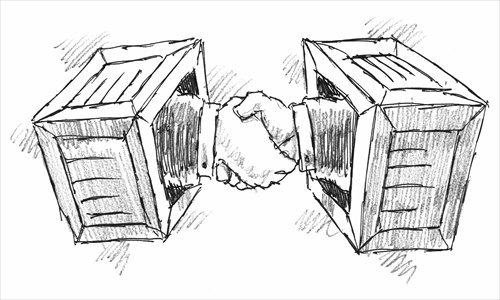HOME >> BUSINESS, OP-ED
FTA a lifeline for troubled S.Korean SMEs
By Zhang Huizhi Source:Global Times Published: 2015-6-4 20:13:01
Cut in import tariffs offers huge opportunity

Illustration: Peter C. Espina/GT
The free trade agreement (FTA) between China and South Korea is expected to be implemented in late 2015 or early 2016. The agreement is China's largest FTA so far, and is expected to stimulate economic growth in both countries, benefiting small and medium-sized enterprises (SMEs) in South Korea and offering opportunities for China to upgrade its own industries.
South Korea's economy is still growing, but the country is facing challenges. According to media reports, after several months of gloom in its export sector, South Korea's central bank announced in April a cut in its forecast for the country's 2015 economic growth from 3.4 percent to 3.1 percent.
One of the challenges facing South Korea's economy is the operating difficulties for its SMEs. Compared with relatively good performance by its large companies, the country's SMEs are struggling. However, the China-South Korea FTA is likely to help these companies gain ground in the Chinese market by removing or cutting import tariffs on goods they produce.
Under the FTA, China will eliminate tariffs on 91 percent of products imported from South Korea.
Large firms are able to move their production from South Korea to overseas consumer markets in order to evade import tariffs in those markets, but SMEs generally do not have this option, so the FTA is likely to be of particular importance for them.
Thanks to the cut in tariffs and large demand in the Chinese market, SMEs that focus on producing household electrical appliances, cosmetics and daily consumer goods may benefit the most. Shen Danyang, spokesman for China's Ministry of Commerce, said on Tuesday that the current 15 percent import tariffs on some household electrical appliances - including refrigerators, electric ovens, rice cookers and microwave ovens - will be completely removed in the next 10 years.
The tariff cut means that prices of these goods will decline in the Chinese market, spurring sales and boosting South Korea's economy by increasing exports to China.
According to Shen, the China-South Korea FTA will help South Korea's GDP grow by about 0.97 percentage points.
As for China, the agreement will allow China's GDP to grow by about 0.34 percentage points, but the opportunities it is expected to offer in terms of industrial upgrading are set to be more important.
The tariff cuts will raise the competitiveness in China of consumer goods from South Korea, exposing Chinese firms to greater external competition, and this will spur traditional manufacturing firms to pursue innovations in their business.
Besides competition, more economic cooperation may also be introduced. The China-South Korea FTA covers 17 areas, including trade in goods and services, as well as investment and trade rules. Measures such as reducing investment barriers and simplifying trade rules will help to promote cooperation on technology and improve the development of Chinese high-tech manufacturing and service sectors.
For instance, South Korea's companies are ahead of Chinese firms in energy-efficient and environmental technologies and there is considerable potential in this field for cooperation.
After the implementation of the FTA, the two countries will also continue negotiations on further liberalized trade in services and bilateral investment.
As for the international industrial chain in Asia, the China-South Korea FTA will only have a limited positive effect on it in the short term. But the agreement will help with other ongoing negotiations over FTAs among Asian countries and regions.
The FTA deal between China and South Korea is likely to help push forward the establishment of a free trade area between China, South Korea and Japan, and it could benefit other regional economic cooperation plans such as the Regional Comprehensive Economic Partnership (RCEP), a multilateral FTA that will include China, South Korea, Japan, India, Australia, New Zealand and the 10 members of the Association of Southeast Asian Nations.
The author is vice dean of the Northeast Asian Studies College at Jilin University. bizopinion@globaltimes.com.cn
Posted in: Expert assessment, Biz Comments